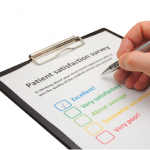E-mail is a popular choice for survey distribution because of its low cost and rapid feedback. Web-based survey tools such as SurveyMonkey allow free or inexpensive e-mail surveys, with costs depending on the number of questions, responses, and other features.
Some survey leaders still use postal surveys, because they believe they give the patient time to formulate an impression of the visit and they encourage greater honesty when done outside the office visit, Woodcock says.
The response rate, however, tends to be lower for mail-based surveys than in-office surveys. Although survey response rates vary widely depending on many factors, one estimate is approximately 75% for in-office surveys vs. 30% for mailed surveys (or 45% with a reminder).5 Dr. King says the response rates for mail surveys from his health system’s vendor range from 5% to 80% depending on the provider being rated.
To increase survey response rates, he recommends telling all new patients at their first visit to fill out the satisfaction survey if they get one.
“The most important thing is to create buy-in among patients and staff by demonstrating that patient satisfaction is very important,” Dr. King says. “We tell them we’re very interested in change and making our practice as good as possible.”
The most important thing is to create buy-in among patients and staff by demonstrating that patient satisfaction is very important. We tell them we’re very interested in change and making our practice as good as possible.
—Charles M. King II, MD
Questions to Ask
Before you develop a survey, Dr. Hong recommends that you define your goal. Is it to confirm that you are providing good service or to improve service? Decide if the survey will assess the most recent visit or care over time. Also, get staff input in creating the survey.
“Patient satisfaction depends on a whole-practice approach,” Hertz says. “Engage the staff by talking with them before you send the survey.”
He recommends not only getting staff suggestions of questions to ask patients but also telling staff members what elements you plan to measure on the survey. “You will see change instantaneously because they want good feedback,” Hertz says.
Patient-satisfaction surveys typically address these areas:
- Convenience or access to care (such as how quickly the phone was answered, ease of getting an appointment, and waiting time at the office);
- Friendliness and helpfulness of staff; and
- The physician interaction (took adequate time with the patient, explained information clearly, and answered questions thoroughly).
An overall assessment should complete the survey. Woodcock recommends including “How satisfied were you with your visit?” and ending with “How likely are you to refer a friend or relative to us?”



